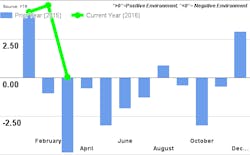Mounting Pressures Will Put Logistics to the Test
After a modest spell of largely positive news, conditions for shippers have leveled off to fair-to-middling levels. The latest Shippers Conditions Index (SCI), which is tracked each month by transportation forecasting firm FTR, came in at a near-neutral reading of 0.4 for the month of March. The flattening of the index score followed four months of positive results.
The SCI, according to FTR, is a compilation of factors affecting the shippers transport environment. Any reading below zero indicates a less-than-ideal environment for shippers, while any score above zero means things are looking good. A neutral score, which is what a 0.4 reading would translate to, means things are just so-so.
“Demand for trucking and rail services have been sluggish so far in 2016,” says Jonathan Starks, chief operating officer at FTF. “The upside for shippers is that capacity has loosened relative to where it has been over the last couple of years, and some contract rate negotiations have shown sizable declines. Anecdotes indicate as much as a double-digit drop in base contract rates, although the data that we track show negative pricing in the dry van market is generally offset by merely weak pricing in other segments. The high inventories that are persisting in the retail supply chain seem to be impacting the dry van market much more significantly.”
The risk of diesel prices rising has put pressure on the fuel cost component of the index, according to Starks, which is reflected in the current month’s decline (the previous index score was 4.7). However, the SCI is expected to remain in positive territory at least until late 2016 as the weakening of freight conditions continues to favor the shipper.
“We are nearing a point in time where the chance of another round of capacity shortages would bring even more pressure to build inventories,” Starks notes. “At the same time, macroeconomic forces could weaken sales enough to kick off a traditional round of inventory reductions. Maintaining adequate stock levels under these countervailing pressures will test the best logistics functions.”
Looking at a separate index, the Cass Freight Index for the month of May indicates that freight shipments index rose 1.3% from April. According to supply chain analyst Rosalyn Wilson, “this represents the high point so far for 2016, but it was still 5.8% below May 2015 and 7.0% lower than May 2014. This year we have failed to see the robust growth in shipments that we expect to see this time of year.”
In May, for instance, railroad carload shipments and container shipments were up 1.9% and 2.1%, respectively. As Wilson points out, the Association of American Railroads (AAR) reported that May carloads were 10.3% lower than in the same month in the 2015, while intermodal container shipments were 3.3% lower than last year.
“Truck tonnage continues to slide for both linehaul and spot markets,” Wilson notes. “Port activity improved slightly in May, but not enough to contribute to a great increase in domestic movements. Industrial production dropped 0.4% in May, with the biggest declines in manufactured goods, especially autos.
On the bright side, if you want to call it a bright side, “the low demand is giving shippers more bargaining power to drive down rates,” Wilson points out. Many trucking companies, she says, are adjusting the size of their available fleet by parking trucks.
It wouldn’t be the worst idea for shippers to take advantage of this current low point situation to lock in rates.

